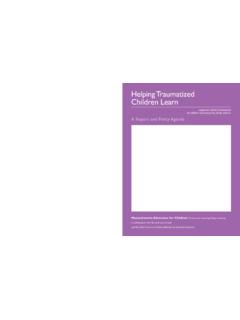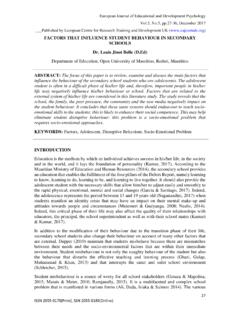Transcription of Supporting Success for Indigenous Students - OECD
1 OECD 2017 Supporting Success for Indigenous Students Supporting Success for Indigenous Students OECD 2017 2 Indigenous peoples are diverse, within and across nations. At the same time, Indigenous children have not generally had access to the same quality of education that other children in their country enjoy. This situation arises, in part, because school leaders and teachers have not always been effectively prepared to teach Indigenous Students , nor are they necessarily provided with resources to help them develop their capabilities and confidence. Some teachers and schools are successfully Supporting Indigenous Students . Indigenous Students report feeling supported when the people at their schools: Care about them and who they are as Indigenous people; Expect them to succeed in education; and, Help them to learn about their cultures, histories and languages.
2 OECD research indicates several ways that teachers can make a big difference in Supporting Success for Indigenous Students : Extra support for Students : Finding ways to change the experiences of individual Students goes a long way. Engaging families: Mutually respectful relationships between schools and parents can have significant benefits for Students . Monitoring and reporting: Tracking progress with data helps educators and families understand where progress is being made. Principals and other school leaders can make all the difference in Supporting teachers and promoting Success for Indigenous Students . In addition, school systems can strengthen the efforts of teachers and principals by focusing on early learning: High quality early childhood education and care (ECEC) for Indigenous children sets them on an early pathway for Success .
3 The issues affecting Indigenous Students are complex, deep and longstanding. What happens in one aspect of Students lives influences the other aspects. For these reasons, Success for Indigenous Students must be defined in a holistic way taking each student into account as a whole person, with their families and communities. Supporting Indigenous student Success means promoting well-being, participation, engagement and achievement. Each of these four components of Success builds on and enhances the others. Taking this broad view of student Success , this brochure describes promising practices to support Indigenous Students using examples from across Canada, New Zealand and Australia.
4 Although the focus is on Indigenous Students , it is clear that the educational practices described here also benefit non- Indigenous Students . Student well-being Participation Engagement Achievement Supporting Success for Indigenous Students OECD 2017 3 Extra Support for Students There are many ways to provide extra support to individual Students . A model that works well for schools with a number of Indigenous Students is to employ Indigenous Support Workers; such staff can address barriers faced by Indigenous Students and identify opportunities to enhance their engagement and Success in education. More specifically, such staff can contribute to ensuring regular attendance of Indigenous Students at school, Supporting teachers in building sound relationships with Indigenous Students and their parents , initiating new curriculum resources, and leading professional development for teachers and whole-of-school activities to grow the cultural competence of staff and Students together.
5 Other models include providing tailored tuition to Indigenous Students , on top of regular classroom activities. This can focus on areas of need, such as language development, or on areas of particular interest to Indigenous Students , including cultural and sporting activities. In a high school in Alberta, a dedicated Indigenous Students room is used as part of a graduate coaching programme. Two coaches are available in the room to assist Students . One is an academic coach and the other is an Indigenous co-ordinator, who assists Students with issues that may be getting in the way of their study programme. Staff at the high school have expectations that Students will graduate, and they hold Students accountable for working hard to achieve this.
6 Engaging Families Better and faster improvements at school can be achieved with families support. Where respect, trust and positive relationships have not always been part of historic or recent experiences between Indigenous communities and schools, Indigenous families are likely to be wary of engaging with school staff. However, where bridges are built and mutually respectful relationships are formed, the benefits for Students can be significant. Schools that achieve sustained improvements for Indigenous Students recognise the key role of Indigenous parents , leaders and other community members and actively build relationships with these important people in their Students lives.
7 There are a number of successful models where schools have effectively engaged Indigenous families in their children s education. The most effective are those that link teachers with parents on education goals for their children and where parents are supported to play a very active role in their children s engagement and learning at school. An elementary school in New Brunswick has almost eliminated academic and behavioural gaps between Indigenous Students and non- Indigenous Students , achieving high results overall. The school is based in a low socio-economic area and has a significant Indigenous student population from the nearby First Nation community.
8 The principal, staff, Photo credits: joseph s l tan matt / Supporting Success for Indigenous Students OECD 2017 4 parents and Students described numerous strategies for achieving their Success , including carefully managing each child s transition to school. Staff meet parents in the First Nation community before children start school to learn about their child s interests, development and needs. Children and their parents visit the school before the year starts, and a welcome ceremony for children and their families takes place once the year has commenced. Monitoring and Reporting Monitoring progress and having the data to do this helps educators and stakeholders to see whether the package of initiatives in place has sufficient breadth and reach to shift overall student outcomes.
9 Without evidence to monitor progress, it is easy to become convinced that progress is being achieved, especially if the new initiatives have wide support. Such information can also build demand amongst parents and Students , in terms of their expectations, voice and influence. An example in Australia that supports teachers to adopt such an approach is the Starting Block Programme, funded by the Cathy Freeman Foundation (Cathy Freeman is an Indigenous Australian Olympic gold medallist, who famously ran her victory lap at the Sydney Olympics draped in the Aboriginal flag). The Starting Block equips teachers with resources to measure and record student progress and achievement in literacy, attendance and general conduct on a daily basis.
10 At the end of each term, Students families and community members attend Starting Block Awards ceremonies to recognise their achievements. The programme is designed to help children learn to set and realise personal goals. School Leadership In schools where Indigenous Students are achieving well, there is generally a highly effective and committed principal who has done whatever it takes to ensure Indigenous Students are at school, engaged in learning and making sound progress. Approaches in such schools tend towards a whole-of-child perspective that puts Students overall well-being as the key priority. Effective principals also set high expectations for teachers and take responsibility for monitoring Indigenous Students academic progress, to ensure expectations of progress are being met and that any needed interventions are put in place in a timely manner.













